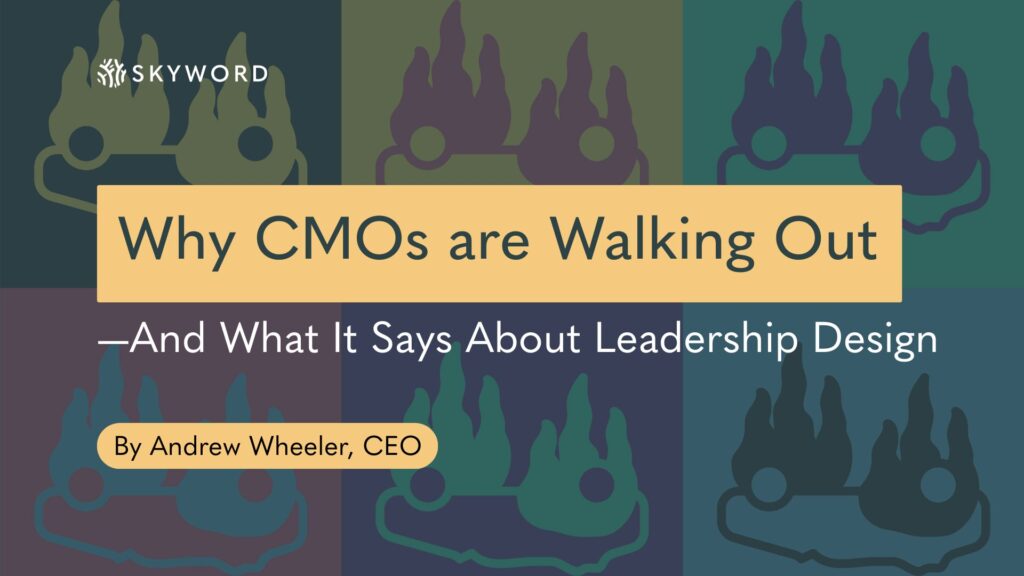Featured
Why CMOs are Walking Out — and What It Says About Leadership Design
By Andrew Wheeler on November 25, 2025
A few weeks ago, I shared a simple observation on LinkedIn:
"Something's breaking in marketing leadership right now. CMOs keep walking — and it's causing a domino effect."
The response wasn't casual. Hundreds of CMOs, CEOs, founders, and operators weighed in with lived experience — and the pattern was unmistakable: expectations compounding, support structures lagging, and accountability concentrating on one role whenever growth slows.
CMOs aren't burning out quietly.
They're walking out.
And the more stories I heard, the clearer the throughline became: This isn't a performance issue. It's a flaw in leadership design.
CMO tenure now sits just above four years — about 18 months shorter than the C-suite average. That gap isn't random. It reflects a modern mandate sitting inside outdated organizational architecture — structures never built to support the complexity, interdependence, or operational load the role now carries.
Across those responses, three themes kept surfacing — fault lines that have moved from anecdotes to structural realities.
Three Fault Lines Driving the CMO Exodus
Rigged Ownership
Marketing carries the weight of growth targets without control over the levers that determine whether growth happens.
One marketing leader put it plainly:
"When every day turns into managing noise instead of building something that matters, you start to check out. Every company's chaos is different, but that's the root problem. It becomes a waste of your time, energy… and frankly, a waste of talent."
Sales owns revenue. Product steers innovation. Finance sets the guardrails.
Marketing sits between them — accountable to everyone, empowered by no one.
A founder friend recently told me about a CMO tasked with driving 30% e-commerce growth while logistics and service budgets were being cut. Reviews fell, conversions followed, and she was out within 18 months. Marketing didn't fail. The system set her up to take the fall.
Until senior leadership shares ownership of growth, CMOs will continue spinning inside machines they do not control.
Scope Inflation
The modern CMO role hasn't evolved — it's ballooned.
"My job doubled, but my resources didn't."
I hear variations of that every week.
Spencer Stuart's latest CMO Tenure Study backs it up: 34% of Fortune 500 CMOs now lead functions outside marketing — from communications to customer experience to parts of the commercial organization. The remit keeps growing while budgets stay flat.
According to another marketing leader:
"The role has expanded faster than most organizations have evolved. Everything the business can't quite solve ends up on the CMO's desk."
When responsibility grows faster than support, the gap gets misread as underperformance.
One SaaS CMO told me she now oversees six functions — brand, growth, advocacy, data, design, and AI — with the same team she had three years ago. That's not "doing more with less." It's attempting to scale a system that no longer fits the work.
Performance Fatigue
The third fault line is the erosion of a CMO's ability to operate at the altitude the role requires.
A commenter described it this way:
"There's no aligned clarity in goals and priorities. Everyone's moving fast — but in different directions. CMOs stop leading strategy and start managing chaos. The CEO's latest idea, board expectations, sales urgency, brand rebuilds, shiny new tools — then throw AI into the mix and it's a sh*tshow."
Nearly 70% of budgets now flow to short-term performance channels.
Strategies reset weekly.
Wins evaporate faster than they can build.
When every quarter becomes a scramble for the next spike, marketing loses the long-horizon work that builds authority, visibility, and resilience. The role collapses from strategic leadership into campaign triage.
The AI Pressure Test
AI didn't create this instability. It exposed it.
Executives expect exponential output. Boards expect transformation on demand. And without coherent structure, AI becomes an accelerant for everything already breaking.
According to one marketing leader:
"CEO's want to leverage AI in the wrong ways without truly understanding where the value comes from. It puts pressure on the entire organization to change without a plan."
You can't feed AI a fractured narrative, competing priorities, and disconnected systems and expect consistent output.
AI amplifies whatever structure you give it.
If the structure is coherent, AI accelerates progress.
If the structure is chaotic, AI accelerates the chaos.
This is the real pressure test: AI forces organizations to confront whether their operational design matches the ambition of their strategy.
The New Standard for Marketing Leadership
Marketing doesn't need a bigger seat at the table. It needs a different table.
The next generation of leadership design requires four commitments:
-
Shared Accountability: Anyone who contributes to revenue participates in the outcome. Sales, Product, and Marketing align around shared metrics — qualified pipeline, customer lifetime value, and multi-touch influence. When incentives sync, everyone moves forward in the same direction.
-
Unified Narrative Ownership: The CMO steps into the role of Chief Customer & Brand Architect — shaping how the organization listens, learns, and communicates. Marketing Operations becomes the engine of content and AI intelligence, lifting every function.
-
Balanced Horizons: Healthy organizations protect both the performance engine and the long-term visibility and authority engine. One without the other creates fragility. Together, they create sustainable momentum.
-
Continuous Design: Alignment isn't a crisis intervention. It's a rhythm. Narrative, data, systems, and strategy must be tuned continuously — not only when something breaks.
From Survival to Sustainability
When organizations rebuild around clarity, shared ownership, and narrative coherence, marketing regains strategic altitude — and CMOs regain the ability to lead instead of absorb.
It's this architectural redesign that anchors our work at Skyword. Through the strategy, production, and measurement systems powered by Accelerator360™, we help enterprise teams rebuild influence, visibility, and sustainable growth.
If you're ready to stop pushing harder and start engineering smarter, reach out — I'm here to help.
